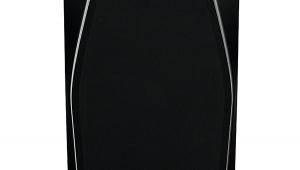Acoustic Insight Aurousal Vsx (£1650)
The high-end hi-fi industry is perhaps unique – certainly unusual – in that it continually holds the present to account, against its past. Many audiophiles, often not with nostalgia foremost among their motivations, wilfully divest themselves of the ‘benefi ts’ of modern technology, preferring vinyl to digital, vacuum electronics to solid state and full-range drive units to the meticulously developed multidriver speakers that purport to represent the state of the art.
If we think of this as a spectrum of design approaches rather than Montagues versus Capulets, the Aurousal VSx – the new, improved version of the VS that won our group test in HFN Aug ’10 – is certainly not at the extreme occupied by single-ended triodes and re-entrant horns. Although the VSx does turn the clock backwards somewhat: in eschewing multiple drivers knitted together with a crossover network in favour of a pair of full-range drivers supplemented by a dome tweeter. But in other respects it is unashamedly modern. Its port-loaded transmission line bass loading, for instance, owes its existence to the modelling and design software developed in the US by Martin King; and its full-range driver – though already something of a classic – is certainly not of the paper cone plus whizzer variety [see box-out].
The first speaker to carry the Aurousal name was the A1 – a compact, refl ex loaded standmount with a single Jordan JX92 aluminiumconed driver, the same unit used in the VS and now VSx. It won many fans for its seamlessness of sound (the sine qua non for single-driver speakers) but viewed objectively it had three obvious problems: its sensitivity was quite low by modern standards and so was its bass output capability. Also, the narrowing treble directivity resulted in a sound lacking the ‘air’ and sparkle of the best modern designs.
To have abandoned the Jordan driver would have thrown baby out with bathwater, so, in creating the fl oorstanding VS, Acoustic Insight’s Kevin Warne addressed the sensitivity and output capability issues by using two JX92s in parallel and adopting the aforementioned transmission line loading. Addition of a tweeter was the only way to address the directivity issue, but, true to the full-range philosophy of the A1, this wasn’t plumbed-in using a conventional crossover. The JX92s continued to operate full-range, without the imposition of a lowpass filter, while the output of the 19mm soft dome tweeter, connected via a highpass network and slightly recessed within the front baffle to finesse its directivity, could be adjusted to taste via a rear panel level control, or disconnected altogether via a small toggle switch to make the ‘with or without’ comparison an easy one.
SO WHAT’S DIFFERENT NOW?
To the naked eye, nothing has changed with the VSx: the drivers are the same, the cabinet dimensions are the same, the price is the same (£1650 for either of the standard wood finishes, light cherry or dark cherry, or £1850 for the pictured four-layer high gloss black lacquer). But inside, a number of refinements have been made. First, although there’s no crossover in series with the Jordan full-range units there is a parallel resistor-inductor network to correct for the ‘baffl e step’ – the 6dB increase in on-axis output that occurs with rising frequency, as the wavelength of sound in the air reduces to become comparable to the front baffle dimensions.
The value of the air-cored inductor in this network has now been halved, which Kevin Warne says gives an improved balance between lower and upper midrange. Second, the fi rst-order high-pass network that controls the tweeter has been improved to optimise the top end of the combined frequency response, between 10 and 20kHz. And third, there have been some changes to the transmission line that loads the rear of the two Jordans. The amount of polymer fi bre absorbent used in the line has been increased, which is claimed to tighten the bass considerably while also suppressing refl ection from the cabinet back wall and damping line resonances at higher frequency (our review of the VS identifi ed a strong line resonance at 160Hz). A further partition has also been added across the inside of the cabinet, front to back, just beneath the lower Jordan, which performs three functions: it adds another resonant system to the bass loading; it supports the wadding; and it further braces the cabinet.
GETTING IT RIGHT
Something that Acoustic Insight might consider adding to the VSx is a plinth or outriggers to carry the spikes, to allow a carefully planted foot to drive them through thick carpet and to improve the stability of this narrow, top-heavy design. I couldn’t achieve a sufficiently well-founded result on my carpet and so resorted to using some spiked MDF platforms that I keep for such occasions.
Even with these in place, though, I found the VSx a tough speaker to get to grips with. It proved unusually finicky with regard to positioning and partnering equipment, and even when I’d extracted the best I could from it I was left in doubt as to whether its revised tonal balance is altogether an improvement.
I began with the Aurousals positioned where I habitually use speakers in my room – a location that has worked well with a wide variety of designs, including the VS – and initially fired them straight at the listening position with the tweeters switched off. Kevin Warne is defensive of the Jordan’s treble performance but for me this just served to confirm why the VSx needs its tweeter, without which the speaker lacks the full spaciousness of which it’s capable, as well as sparkle and pizzazz.
With the tweeter switched on, I then experimented with trading-off tweeter level and toe-in: a vital procedure if you’re to get the best out of the VSx. Aurousal recommends that the speakers’ axes cross ahead of the listening seat but that’s an arrangement I’ve rarely found successful. Usually I prefer the speakers to be turned the other way so that their axes cross behind the listening position instead – as I did with the VS and again here. Fifteen to 20° toe-in from the straight ahead was optimal, with the tweeter level control about half-way through its travel.
Set up like this I found the VSx a bit of a curate’s egg. It did some things very well, such as taming the sometimes forward balance of the big band in J J Johnson’s The Brass Orchestra [Verve 314 537 321-2] or fully developing the marvellous piano sound that opens the slow movement of Melcer’s First Piano Concerto, played by Jonathan Plowright and the BBC Scottish Symphony Orchestra [Hyperion, 16/44.1 download] – one of Tony Faulkner’s filterless CD masterings.
And the bass does indeed have impressive new authority, as evinced by Fred Simon’s ‘Poetspeak’ [Naim Label, 24/96 download]. But the VSx failed to deliver the crisp percussion sound I expect from the opening of Christy Baron’s ‘Got To Get You Into My Life’ [Chesky 24/96 download from HDtracks] and sounded somewhat thickened – on both vocal and piano – in ‘Goin’ Back To Joe’s’ [Naim Label 24/96 download featuring Laurence Hobgood and Kurt Elling]. The lightness of touch needed to make Natalie Clein’s playing of the Kodály cello miniatures Epigrams [Hyperion 16/44.1 download] really sing was also missing.
TAKING A NEW POSITION
Kevin Warne delivered the speakers personally and during his visit suggested a very different position for them, with their inner back corners aligned to the edges of the window bay at that end of my listening room (if you’ve a copy of HFN May ’11 you’ll see a floor plan). So I tried that positioning next, again experimenting with toe-in and tweeter level to achieve the best result, again preferring the speakers under-rotated so that their axes crossed behind the listening seat.
It was a pleasant surprise how well the new location worked. There was a little foreshortening of image depth, and the bass, although it didn’t become overbearing, did lose some of its impressive tautness – both of which effects I expected. What I didn’t anticipate was a realignment of the VSx’s tonal balance that resulted in it sounding more integrated, more homogeneous than it had previously. All the above pieces of music were improved, although I still couldn’t coax quite the crisp percussion sound I was looking for from ‘Got To Get You Into My Life’ without the tweeter level being raised so much as to emphasise vocal sibilants.
Even in this layout, though, there was something still missing from the VSx’s armoury, a little lack of energy and precision that I suspect is associated with the on-axis presence band suckout identified in the Lab Report, which varies according to the setting of the tweeter level control. Some listeners, I know, don’t mind this effect one bit – me, I suffer withdrawal.
VERDICT
More than most these are speakers you should hear in your own home for a week before buying. If you can fi nd a sweet spot for them – which may involve positioning them somewhere you didn’t expect – and you don’t mind the denuded presence band with the tweeter engaged, then their seamless fl ow of sound may beguile you. If you value energy and precision more than euphony, they may not be quite your bag.
Originally published in the September 2011 issue



























































